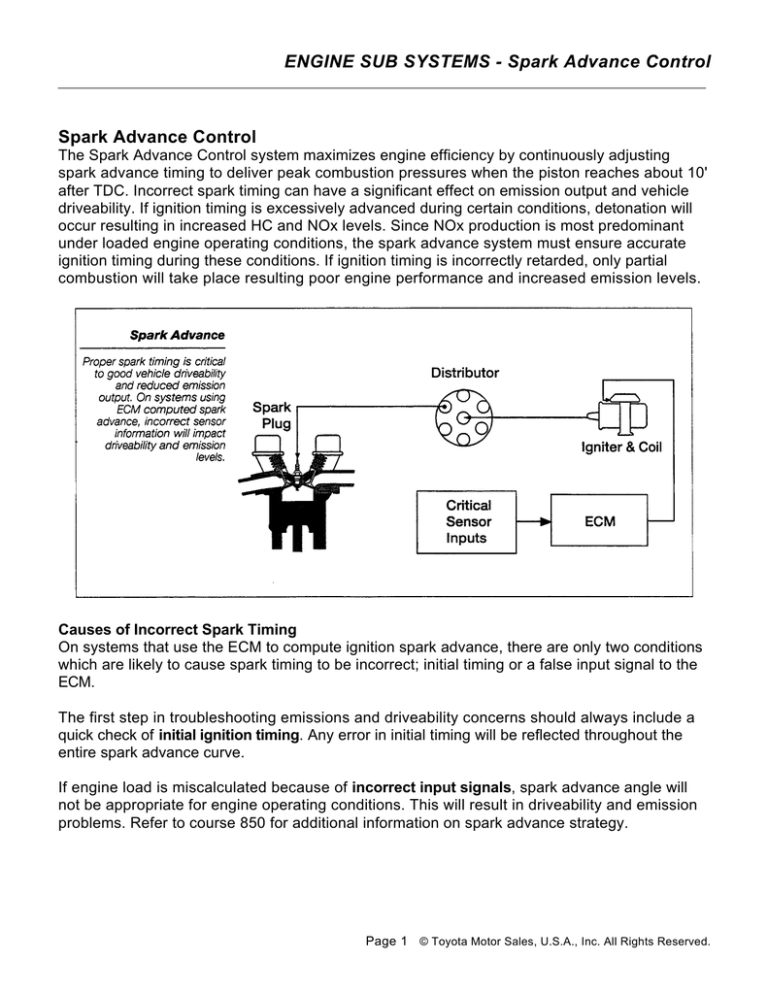
ENGINE SUB SYSTEMS - Spark Advance Control
Spark Advance Control
The Spark Advance Control system maximizes engine efficiency by continuously adjusting
spark advance timing to deliver peak combustion pressures when the piston reaches about 10'
after TDC. Incorrect spark timing can have a significant effect on emission output and vehicle
driveability. If ignition timing is excessively advanced during certain conditions, detonation will
occur resulting in increased HC and NOx levels. Since NOx production is most predominant
under loaded engine operating conditions, the spark advance system must ensure accurate
ignition timing during these conditions. If ignition timing is incorrectly retarded, only partial
combustion will take place resulting poor engine performance and increased emission levels.
Causes of Incorrect Spark Timing
On systems that use the ECM to compute ignition spark advance, there are only two conditions
which are likely to cause spark timing to be incorrect; initial timing or a false input signal to the
ECM.
The first step in troubleshooting emissions and driveability concerns should always include a
quick check of initial ignition timing. Any error in initial timing will be reflected throughout the
entire spark advance curve.
If engine load is miscalculated because of incorrect input signals, spark advance angle will
not be appropriate for engine operating conditions. This will result in driveability and emission
problems. Refer to course 850 for additional information on spark advance strategy.
Page 1 © Toyota Motor Sales, U.S.A., Inc. All Rights Reserved.
ENGINE SUB SYSTEMS - Spark Advance Control
The Effects of Fuel Octane
Toyota engines equipped with a knock detection system are very sensitive to fuel octane levels.
Motor fuels with low octane ratings will cause the engine to detonate, which will in turn, cause
the detonation retard system to retard timing. On some vehicles with advanced ECM operating
strategies, an adaptive memory factor is used to track signals from the knock sensor. When
detonation occurs frequently, the ECM relearns the basic spark advance curve, retarding spark
throughout the entire engine operating range. This retarded spark curve will negatively effect
engine performance and fuel economy under all driving conditions, even after a tank of higher
octane fuel is purchased. The retarded spark curve will remain stored in the ECM keep alive
memory until the engine is operated for a substantial amount of time on the higher octane fuel,
or until the "keep alive memory" is cleared by removing power from the BATT terminal.
Purpose of Spark Advance Control Systems
The amount of spark advance needed by the engine varies depending on a number of different
operating conditions. Generally, spark advance follows the following strategy:
• spark advance increases with higher engine speeds for performance and fuel economy.
• spark advance needs to decrease under heavy load conditions to avoid detonation.
They are many variables the system must consider when determining the proper spark lead
time. Coolant temperature, fuel quality, and engine load are just a few of the many factors that
can significantly impact ideal ignition time. The ECM determines proper spark timing by
applying various input signals against a preprogrammed spark advance strategy or "map".
Fuel injected Toyota vehicles use either a mechanical or electronic spark advance control
system. They are referred to as either conventional EFI ignition system (mechanical), Variable
Advance Spark Timing (VAST) or Electronic Spark Advance (ESA).
Page 2 © Toyota Motor Sales, U.S.A., Inc. All Rights Reserved.
ENGINE SUB SYSTEMS - Spark Advance Control
Effects of Spark Advance on Emissions and Driveability
• Too much spark advance, particularly during high engine load conditions, increases the
likelihood of engine detonation and increases combustion temperature and pressure.
This results in an increase in HC and NOx output, decreased engine performance, and
possible permanent damage the engine.
• Too little spark advance causes only partial combustion of the air/ fuel charge, resulting
in very poor engine performance and fuel economy. Partial combustion will also result in
an increase in CO levels.
Functional Testing
Spark advance problems can result from an incorrect initial timing setting or a problem with
spark advance during operation. Before attempting to check spark advance during operating
conditions, the initial or "base" ignition timing setting should checked and adjusted.
This procedure varies between systems, but on TCCS equipped vehicles, it generally requires
jumping terminals at an underhood check connector (DLC1) to default the TCCS system to
initial timing. After checking or adjusting initial timing, remove the test wire to inform the ECM to
reestablish corrective control over timing. Refer to the Repair Manual for details on performing
this procedure.
Page 3 © Toyota Motor Sales, U.S.A., Inc. All Rights Reserved.
ENGINE SUB SYSTEMS - Spark Advance Control
Even with initial timing correct, it is still possible that the system is miscalculating ignition
timing as a result of incorrect sensor inputs. For example, if an airflow meter indicates light
engine load, when in fact, the engine is experiencing high engine load, the ECM may incorrectly
respond by over advancing ignition timing to the point of causing detonation. Refer to course
850 and 873 handbook for additional information on spark advance control strategy.
If inaccurate sensor inputs are suspected on earlier EFI and TCCS vehicles, it is recommended
that you perform standard voltage checks of all major sensor inputs to the ECM. Compare
these readings to those listed on the standard voltage chart on the Repair Manual or readings
obtained from other known good vehicles. On OBD-II vehicles, you may observe ignition timing
and identify incorrect signal data using the Diagnostic Tester. Some of the more important
spark control parameters include engine speed, engine load, throttle angle, and coolant
temperature.
On early EFI vehicles, all spark advance is handled by mechanical means. This system uses a
centrifugal advance mechanism to represent engine speed and vacuum advance mechanism
to represent engine load. Resolving advance problems with this type system requires
inspecting governor weights, springs, pivots, signal rotor, vacuum diaphragm, vacuum signal
source, breaker plate, etc.
Page 4 © Toyota Motor Sales, U.S.A., Inc. All Rights Reserved.
ENGINE SUB SYSTEMS - Spark Advance Control
Knock Detection Control
The KNK (knock) input signal is critical in the prevention of engine detonation. The ECM uses
the knock sensor(s) to determine when, and to what degree, engine detonation is occurring
and then retards ignition timing as needed. The spark advance program is designed to provide
the maximum spark advance possible, while keeping the engine from producing an audible
"ping". If problems occur with this input signal, detonation may result, producing significant
levels of HC and NOx emissions.
The ECM is designed to filter out KNK signal voltages that it considers are outside of the engine
detonation range. Thus, a check of a knock control system by tapping on the engine close to the
knock sensor may produce an output signal, but will not cause spark timing to retard. A check of
the KNK signal pattern using the Diagnostic Tester Oscilloscope or lab scope may provide you
the most diagnostic information.
Page 5 © Toyota Motor Sales, U.S.A., Inc. All Rights Reserved.

